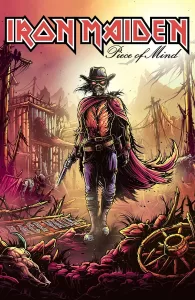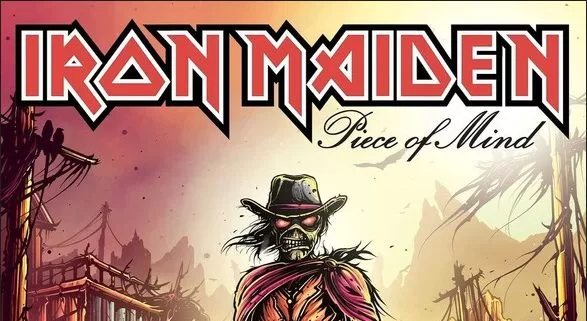Forty years ago, the fourth studio album of Iron Maiden’s titled Piece of Mind was released. The album’s art is iconic with mascot Eddie lobotomized, bound by nothing more than a straightjacket and chains. The contents of the record therein are just as evocative. From the piercingly beautiful and warrior-like vocal styling of Bruce Dickinson, the melodic, jackhammer guitars of both Dave Murray and Adrian Smith along with the fucking thunderous rhythm section of bassist Steve Harris and (then newly joined and current drummer) Nicko McBrain, each song was festooned with literary references galore and a fire inside that could topple an empire.
Forty years later, Z2 Comics have joined forces with Iron Maiden to bring you a gorgeous, 75-page tome, covering different writers’ and artists’ unique and inspired takes on each of the 9 songs on this album. Here’s my album-like breakdown of the contents therein.
Review:
“Where Eagles Dare” is the first song on the album. Inspired by the 1968 film of the same name, it’s also the first story out of the gate. Penned by Steven Grant (Punisher) with art from Carson Thorn, the story is imbued with unwavering grit and tension. The artwork is kinetic and the beautiful use of blues, whites, and blacks by colorist DC Alonso gives the feeling of tranquility below while chaos reigns from above.
Next, we have “Revelations” penned by Tony Lee from a story from the band’s very own Bruce Dickinson. Artist Damian Worm (The October Faction) creates a world that is dark empowering and sensual. The song, inspired by famed occultist and all-around bad-ass Aleister Crowley, lends itself effortlessly to the story of inquisitiveness and enlightenment. Powerful stuff.
“Flight of Icarus” written by Ivan Brandon with art by Francesco Dossena is about a warrior’s son, Ceo. The message that lies therein is universal and strong, about carving your own path, and never mollifying others. We get a glimpse into what one can sacrifice for status and hubris. The art is soft almost having a sketch-like quality to it and the warm pastels from colorist Heather Moore give the entire world a very dream-like quality. The warm interaction between a son and his mother wonderfully contrasted by the cold, steely nature of his father is captured perfectly through the pages, culminating in the young one’s audacious moment of truth.
Screenwriter Sacha Gervasi (My Dinner with Hervé) and artist Christian Nosado helm “Die With Your Boots On.” The funny thing about this particular song is there isn’t too much information on the inspiration behind it. It was written during the time of the Cold War with an apocalyptic bent and self-fulfilling prophecy heavily present in the lyrics. From there, we’re given a glimpse into the relationship of a soldier and a woman with a lot more to her than meets the eye. What transpires feels very cinematic in both tender intimacy and bloody mayhem, ending on a pretty neat twist. The art reminds me of a 1980s comic book, which seems very fitting given the original intent of the song.
“The Trooper” scribed by Atomic Blonde creator Antony Johnston with art from Staz Johnson gives us a sweeping poem through five major battles in human civilization. The narrator extols the brutality of war because of what is being fought for. Much like militia on the battlefield, the words roar in the beginning, attack in the middle, and lie dormant in the end, harking back to the old adage “those who don’t learn from history are doomed to repeat it.” It’s certainly a unique version of storytelling and one of my favorites in this book.
Writers Leah Moore and John Reppion give us their trippy interpretation of “Still Life.” Originally inspired by a 1964 short story by British author Ramsey Campbell, we see a very popular mythos wildly overtaking a painter and his descent into madness when he finds a provincial Lakeside house in the English countryside. His narration is presented in scribbled notes, which I think is a brilliant mood, adding another layer to the storytelling. The art by John J. Pearson is insanely gorgeous, simultaneously dreamy, violent, and magnetic in a very painterly style. Fun fact: “Still Life” is a song with a hidden message if played backward, done as a goof on the laughable “Satanic Panic” of the time.
“Quest for Fire” takes us prehistoric, compliments of comedian/comic-writer/metalhead Brian Posehn, artist Michael Avon Oeming (Powers), and letterer Taki Soma. Set in Paleolithic Europe 80,000 years ago, both the song and the story are influenced by Jean-Jacques Annaud’s 1981 film of the same name. Brian puts his own humorous, bad-ass spin on the song, including a T. Rex chomping on a caveman, and immediately, as instructed, I’m casting all inaccuracies aside for the compelling story of how the gift of Prometheus was not something to be trifled with. The art was rough and jagged with stark blacks, warm browns, and radiant yellows that not only bolstered the smartly sparse script but also gave the story real heat.
Bruce Dickinson’s love of both famed post-war novelist Yukio Mishima and real-life rōnin Miyamoto Musashi, “Sun and Steel” puts us in the very able hands of iZombie co-creator Chris Roberson and artist Danijel Žeželj as we’ve now traveled to Edo Period Japan to follow a young swordsman. The narrative itself takes a circular approach, a play on the dying words of a samurai who is defeated before his very eyes by old age until our protagonist is old and comes across young blood. The art is intoxicatingly inky and DC Larson’s vibrant colors give the whole story a very arthouse cinema feeling. No notes!
“To Tame a Land” concludes the album as well as the book. Written and illustrated by Alison Sampson (The Department of Truth), this story is wildly unlike the rest in look and it being wholly wordless, based on a song originally titled “Dune” before Frank Herbert himself had denied lending use of his seminal work’s name to Iron Maiden (since he was not a fan of rock music, especially the heavier good shit). Herbert’s loss is both the band’s last laugh as well as Sampson’s when we travel through two different worlds, one seen, and one unseen. One crumbling and one rebuilding. The strategic use of one massive panel hovering over six smaller ones is brilliant, as it introduces a new way of enjoying a comic, allowing our neural network to create new paths and evolve. Isn’t that what sci-fi is all about? All I will about the ending is it’s something both Ursala K. Le Guin and Arthur C. Clarke would have a good chuckle over. It’s definitely my favorite story and a bombastic bookend to these nine vignettes.
Additionally, we get a very heartfelt and powerful letter straight from the Iron Maidan Fan Club, compliments of Anthrax’s own Scott Ian. We get nine piercingly beautiful Chapter Plates, compliments of Montos, Nat Jones, Carin Hazmat, Steve Chanks, Travis Knight, Rantz A. Hoseley, Jan Meininghaus, Jay Seldhof, and Kyle Hotz with Dan Brown. We get a boatload of Eddie art as well as fan testimonials prefacing every story. The writer/artist/colorist profiles are a robust two pages and a letter written by the band’s manager Rod Smallwood greets us with a richly detailed account of what it was like making the highly collaborative album.

This anthology is a must for any fan of Iron Maiden, available in four different Collector editions at Z2 Comics.
5/5 Stars.

